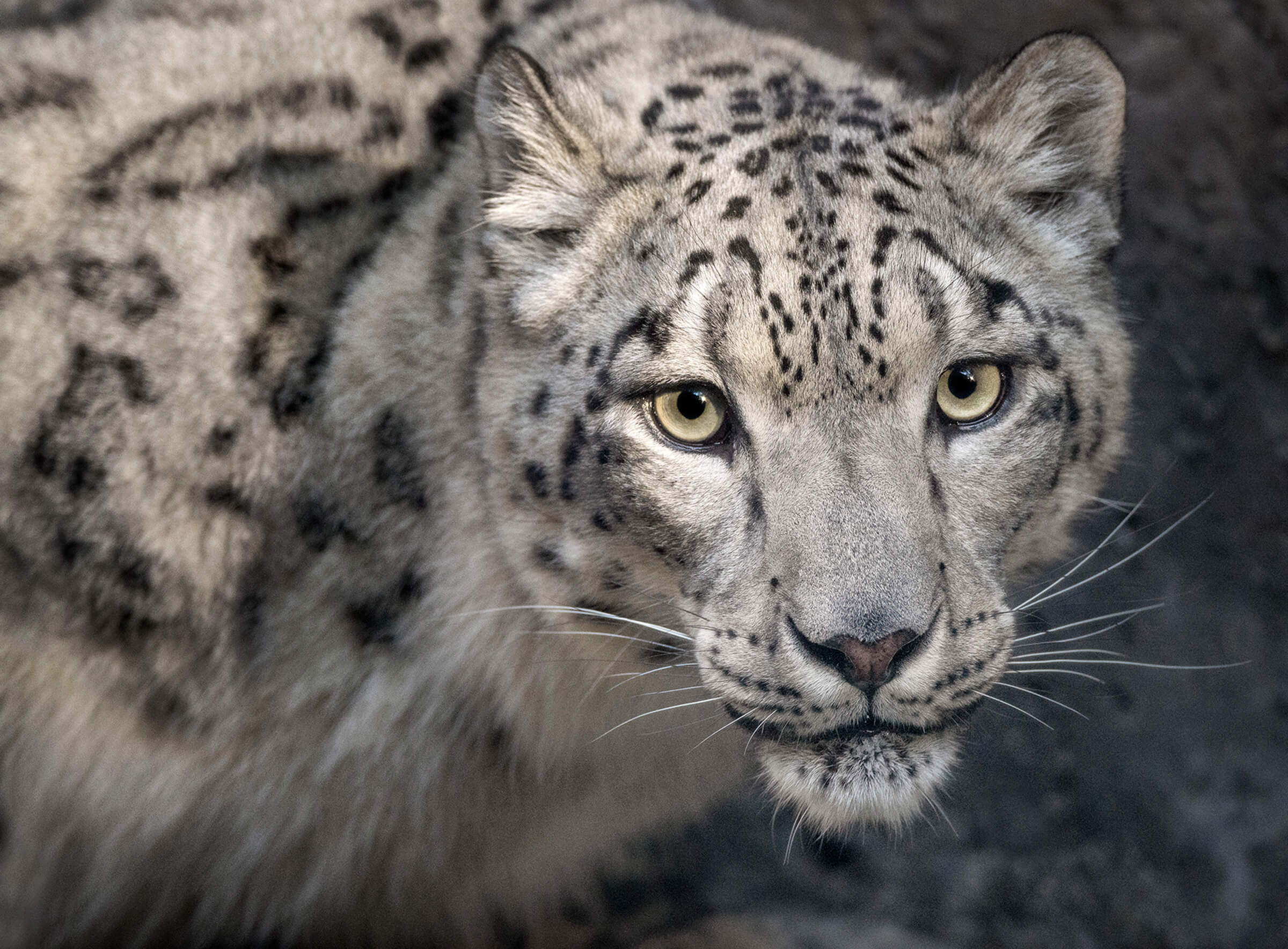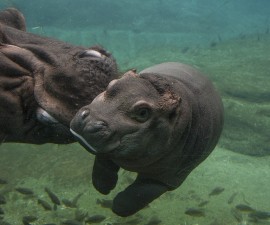BY Eston Ellis
Photography by Ken Bohn
Walk past the snow leopard exhibit near the top of Center Street at the San Diego Zoo, and your eyes just might deceive you. Unless you look closely among the rocks and foliage, you may not see anything at all. Then suddenly, what appears to be the shadow of tree leaves against a rock ledge will begin to move, revealing that the rippling shadows are actually dark rosettes in the silky coat of a lounging snow leopard Panthera uncia.
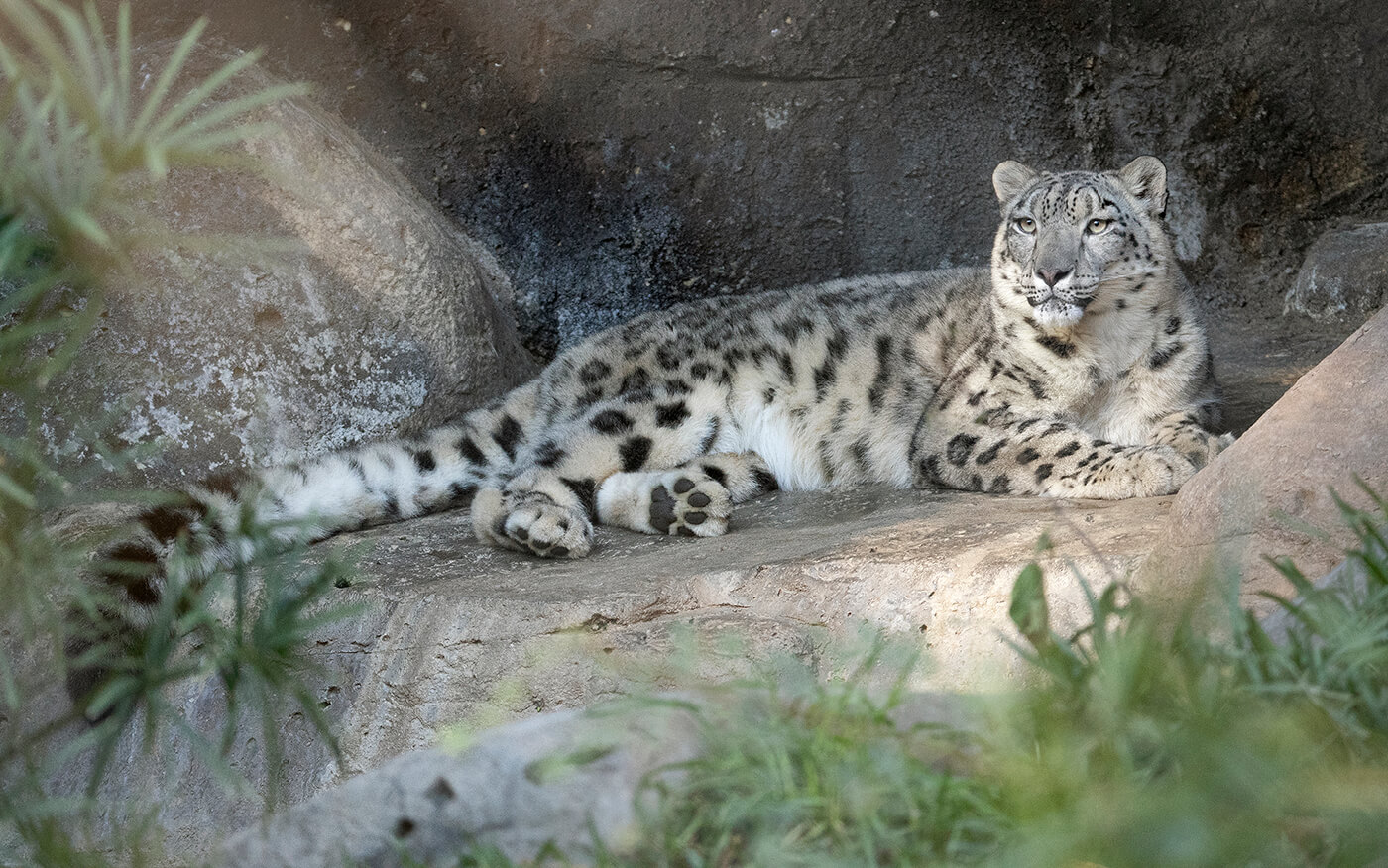
SNOW ON THE ROCKS
Snow leopards’ ability to blend into their surroundings helps make them difficult to locate in the rugged mountains of their Asian habitats—and sometimes even among the rocks and vegetation of their exhibit at the San Diego Zoo!
 More than half of snow leopard killings may be retribution related, caused by livestock herders.
More than half of snow leopard killings may be retribution related, caused by livestock herders.
It’s no wonder this master of camouflage has been called “the ghost cat.” Historically, that ability to seemingly disappear has been a key factor in snow leopards’ survival in their cold, dry, and barren habitats in the mountains of Asia. But no one can hide forever, and snow leopards today face many threats—including poaching for their thick, beautiful coats and their body parts; loss of habitat as areas are developed for mining; a decrease in the wild sheep and goats they feed on; and killings of snow leopards by livestock herders. Today, fewer than 7,000 snow leopards are thought to exist in the 12 countries of their native range—and the actual number may be as low as 3,500.
The Zoo has had snow leopards since 1949—and it was reported that on the day our first snow leopards arrived, San Diego experienced its first snowfall in more than 50 years. Since then, 13 snow leopard cubs have been born at the Zoo. However, there have been no new births here in more than 20 years.
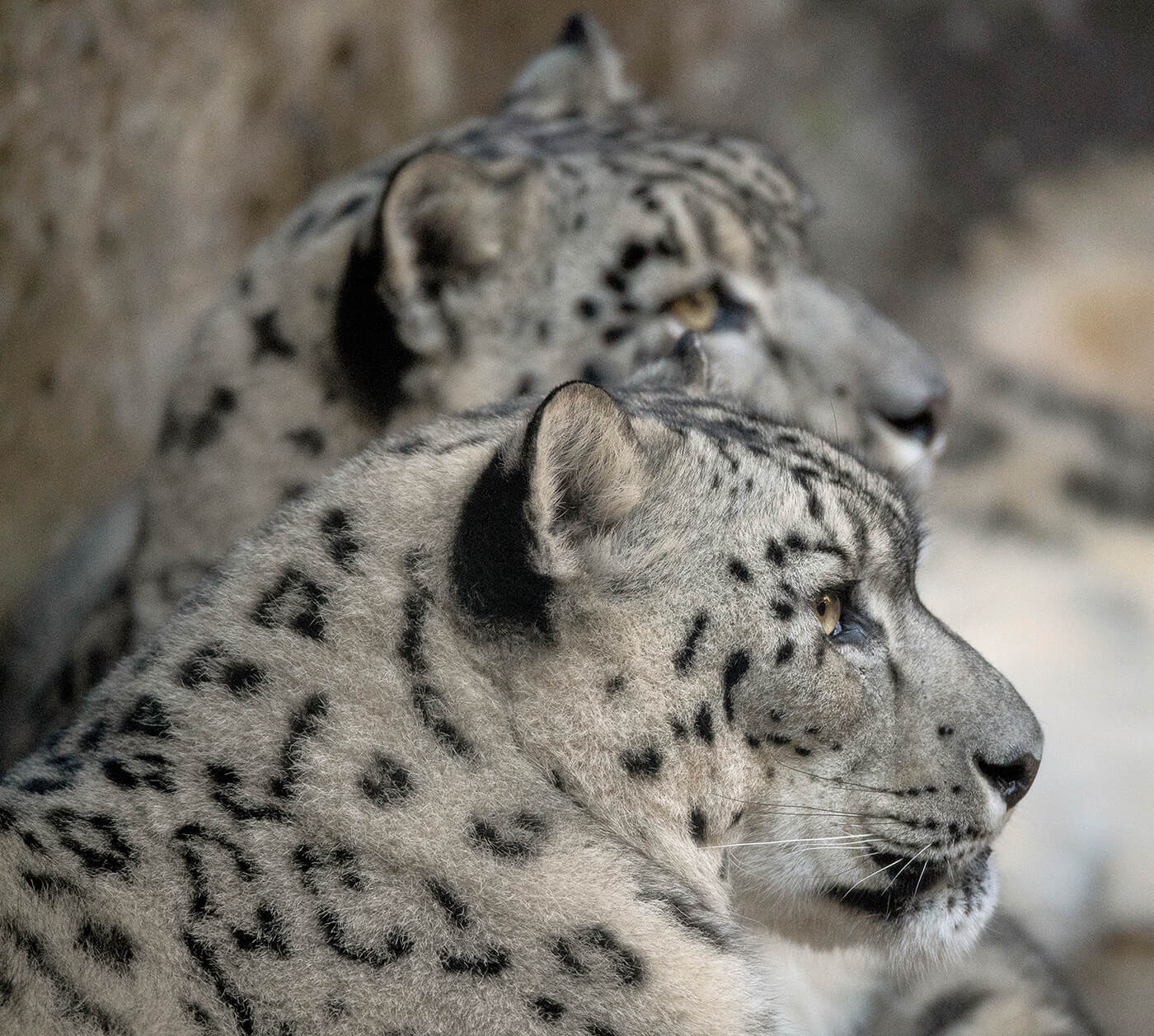
DYNAMIC DUO
Snow leopards Ramil and Penny became much more interested in each other after moving from Panda Canyon to their new exhibit near the top of Center Street.
That may change in 2019, as a closer relationship has been developing between the Zoo’s current pair of snow leopards—six-year-old Ramil and five-year-old Penny. The San Diego Zoo participates in the snow leopard Species Survival Plan program, administered through the Association of Zoos and Aquariums (AZA), and Ramil and Penny have been recommended for breeding to boost the population of this vulnerable species. However, three years of prior attempts to get this inexperienced pair together proved unsuccessful.
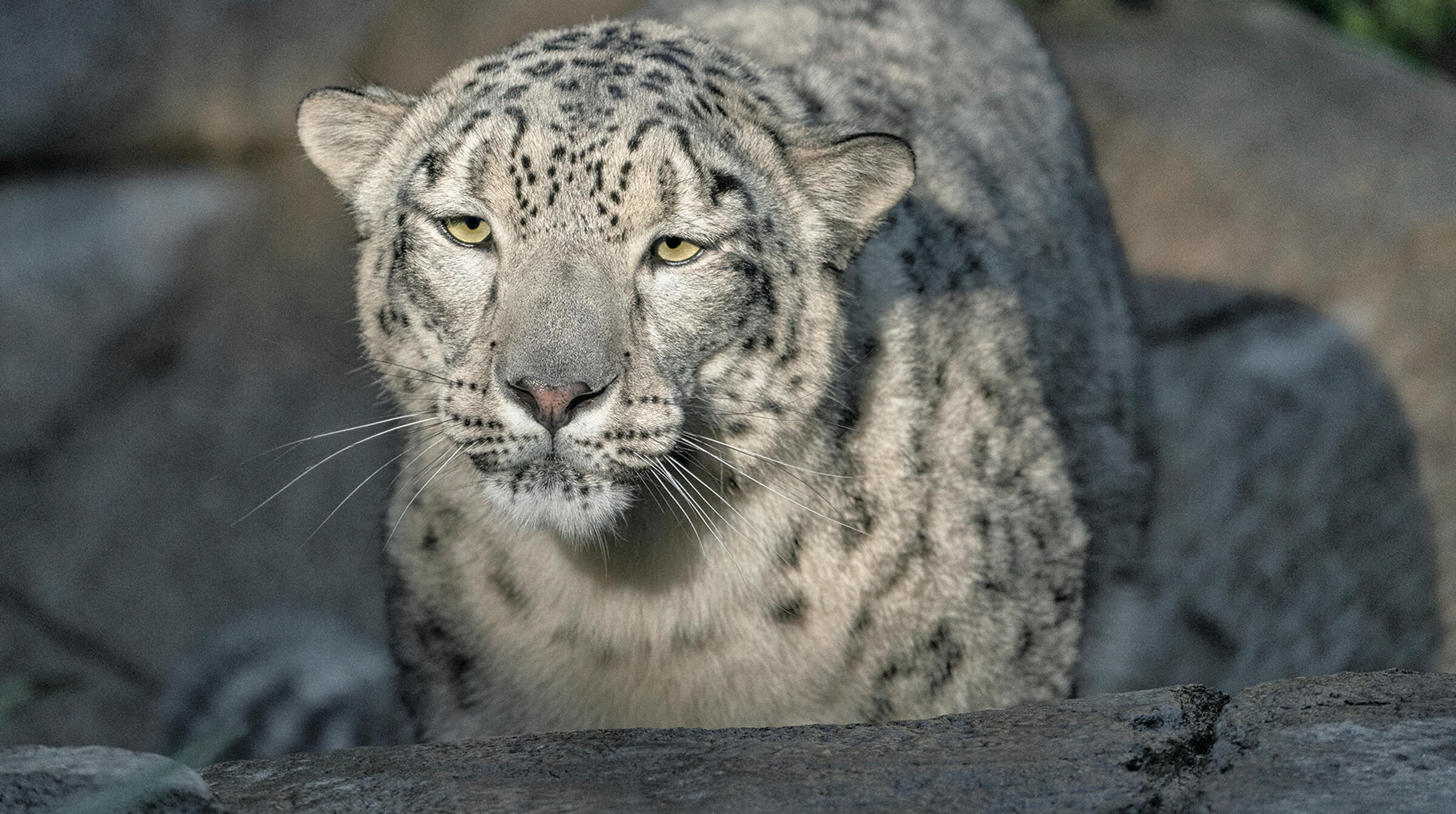
From Hissy to Kissy?
Last year, Ramil and Penny were living in the Asian leopards habitat in Panda Canyon, sharing the spotlight with the Zoo’s critically endangered Amur leopards. But when another exhibit area near the top of Center Street became available, it was decided to let the snow leopard couple move out on their own. The result? Last winter, Ramil became interested in Penny for the first time. “After moving up here, away from Amur leopards, there has been a big change in him,” said senior keeper Todd Speis.
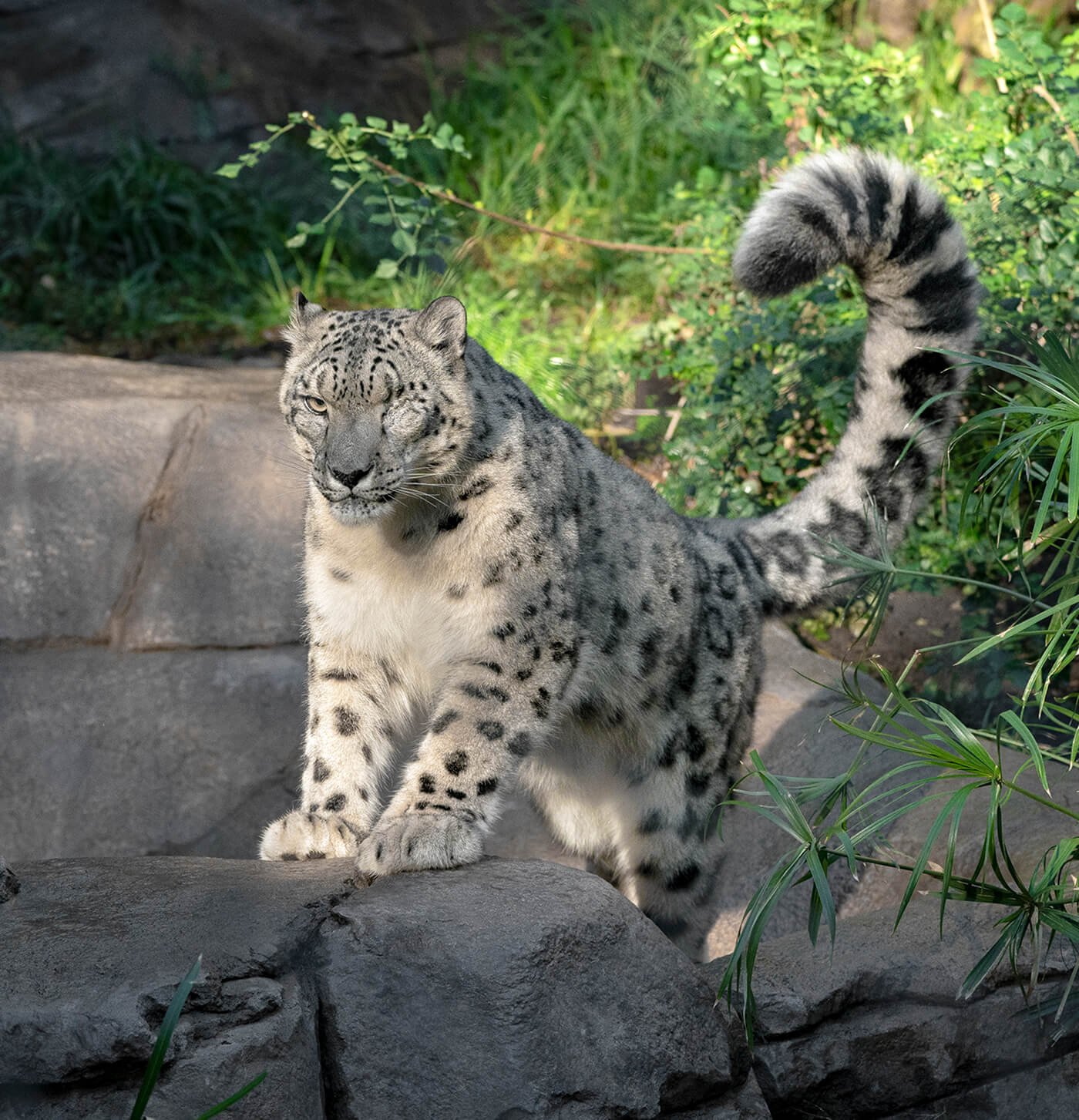
MEET RAMIL
Six-year-old male snow leopard Ramil has only one eye, as a result of surgery to resolve an eye problem that developed prior to his arrival at the Zoo. However, Ramil’s vision today is excellent, he is remarkably agile, and he is known for making spectacular, well-targeted leaps and landings.
 Poaching has had a dramatic affect on snow leopard numbers, with an average of 250 to 450 cats killed and traded each year from 2008 to 2016—and poachers have also decreased the population of many of its wild sheep and goat prey species, including ibex.
Poaching has had a dramatic affect on snow leopard numbers, with an average of 250 to 450 cats killed and traded each year from 2008 to 2016—and poachers have also decreased the population of many of its wild sheep and goat prey species, including ibex.
“In previous years, Penny had the desire to mate, but Ramil seemed scared and didn’t know what to do,” explained Greg Vicino, curator of Applied Animal Welfare at San Diego Zoo Global. “Basically, they needed some privacy—and getting him away from another male (a nearby Amur leopard) that was, essentially, in his territory, was important.”
Although Penny and Ramil mated last year, she did not become pregnant. After mating, Penny was temporarily moved to a separate exhibit in Panda Canyon so that she could be closely monitored, because the gestation period for snow leopards is a short 100 days. Penny returned to her shared exhibit with Ramil when it was confirmed that she was not pregnant.
Most zoos keep male and female cats apart, only putting them together for one 24-hour period to breed. San Diego Zoo animal care experts have decided against that approach, in an effort to make life in the Asian cats’ three Zoo exhibits—in Panda Canyon, at Africa Rocks, and on Center Street—more like their life in the wild. As part of the husbandry strategy for Asian cats, the San Diego Zoo’s Amur leopard cub parents, Satka and Oskar, were allowed to stay together for more than a month and a half, which ultimately resulted in a pregnancy and two healthy cubs.
Keepers hope the same strategy will lead to a successful pregnancy and cubs for Ramil and Penny. “Putting Ramil and Penny together 24/7, away from the Amur leopards, has already made a big difference,” Greg said. “Now, he has learned to read her signals very well. It is a testament to changing the rules.”
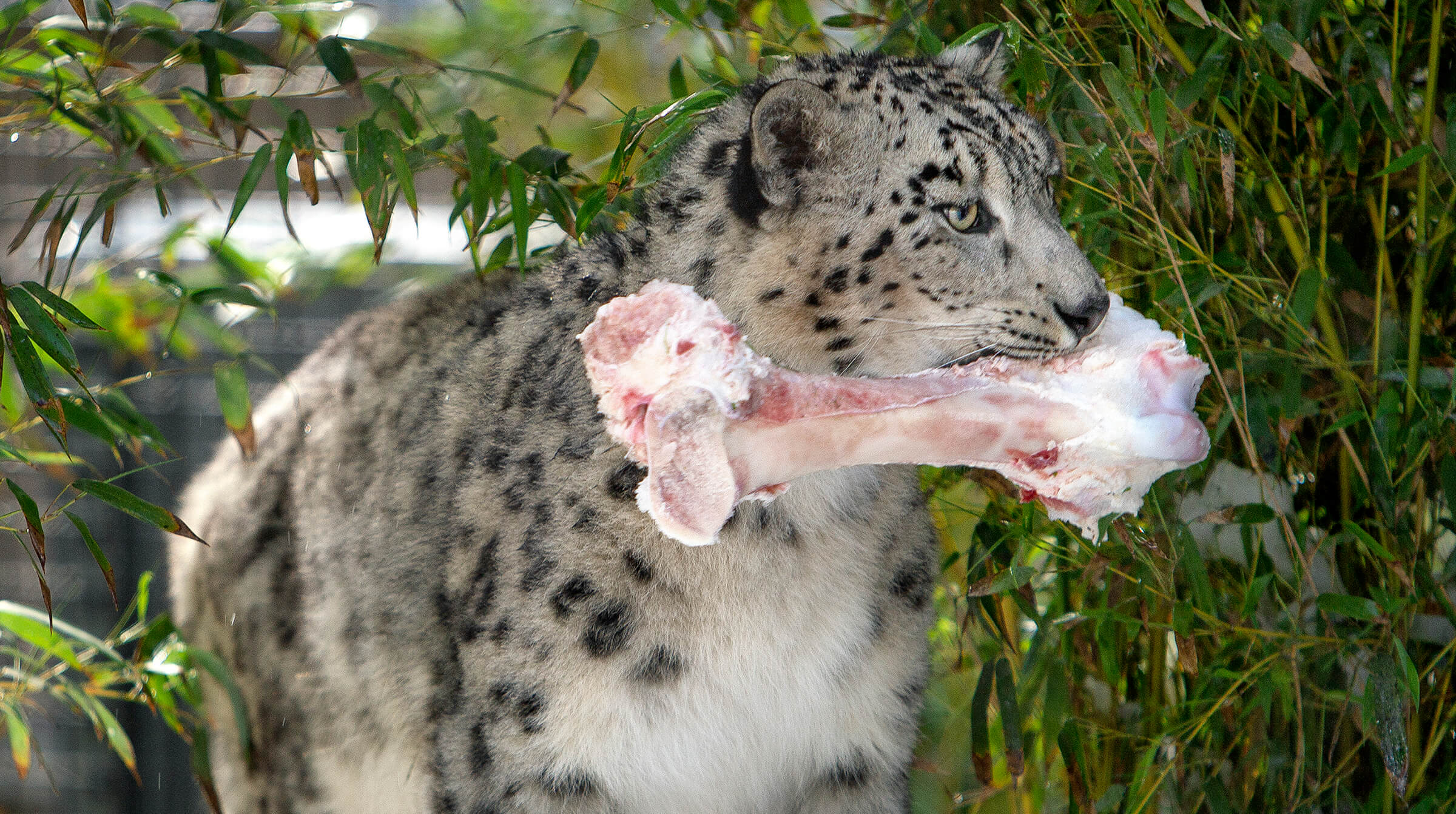
Strategies for More Natural Behavior
With this outcome-based husbandry, which is designed to promote more—and repeatable—natural behaviors in the Zoo’s Asian cats, one of the goals is to eliminate routines and predictability in their daily lives, including with feedings. “Previously, a specific food item would be delivered on a set day of the week—based on our schedule, not theirs,” explained Jessica Sheftel, animal welfare specialist at the Zoo. “Now, Nutrition delivers two weeks’ worth of food at once—mostly prey items—which are kept in a freezer at the exhibit.” Keepers make random choices of which menu items to feed over those two weeks. “One day the cats might get a rabbit, the next day they might get a whole lamb carcass, and the next day they might fast—experiences that are more like what they would encounter in the wild,” Greg said.
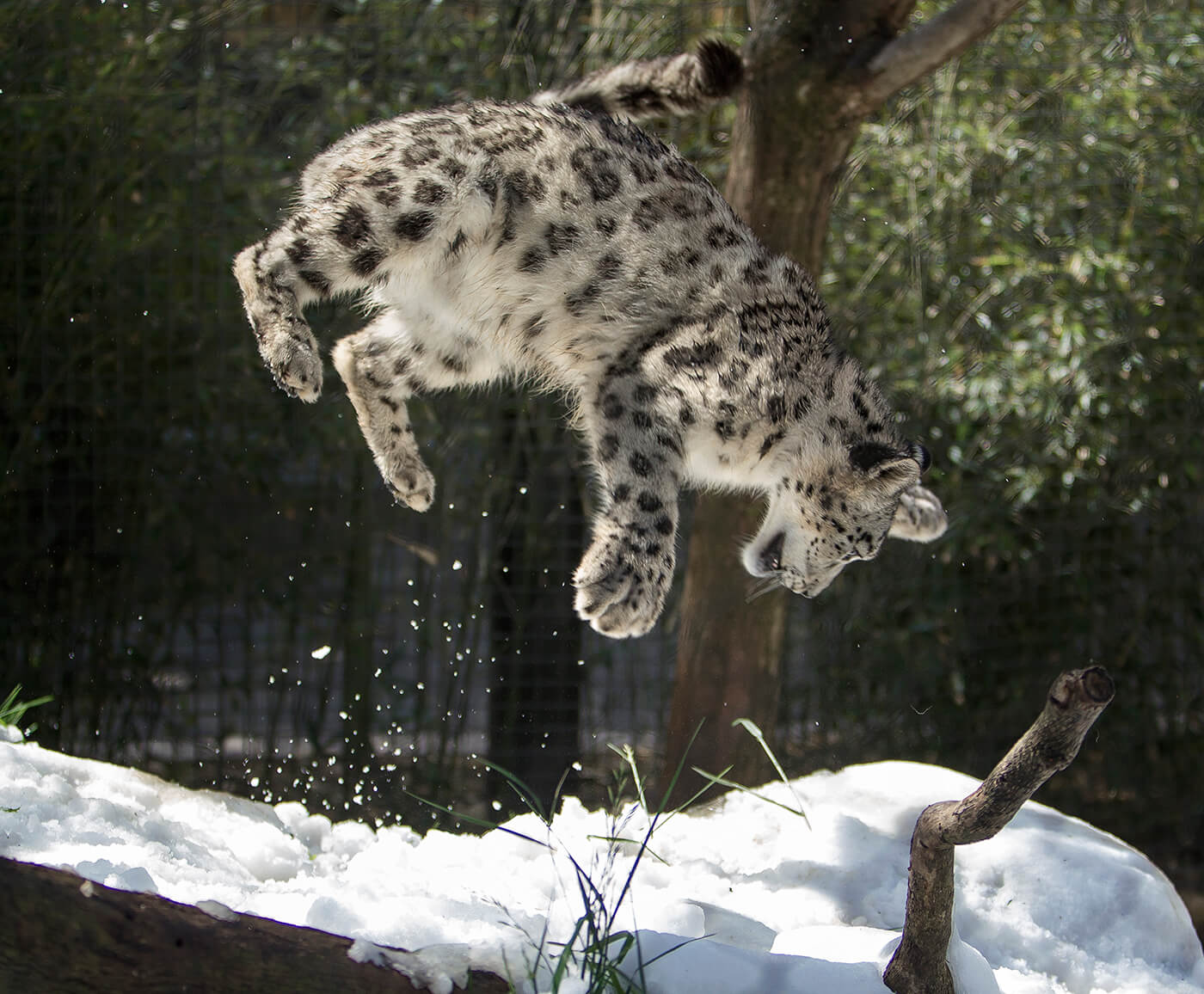
DASHING THROUGH THE SNOW
Snow leopards’ long and flexible hind legs allow them to make spectacular leaps, their short forelegs and oversized paws help provide sure footing in ice and snow, and their extra-long tail helps them maintain their balance even when traversing wobbly tree limbs.
 A total of 23 snow leopards have been fitted with GPS-tracking collars and observed in the Tost Mountains over the past 10 years, to provide needed data on ranges, habitat use, diet, and more.
A total of 23 snow leopards have been fitted with GPS-tracking collars and observed in the Tost Mountains over the past 10 years, to provide needed data on ranges, habitat use, diet, and more.
“Instead of focusing on input—what we provide to the cats—we focus on outcomes and outputs—what the cats do,” Greg said. “We want to see the cats demonstrating more of their natural behaviors, at a frequency we would see in the wild.”
“Each day, there’s something different in their exhibit,” Todd said. If they get a carcass, it will be anchored down so they work all day for it. “We might also block an access route to drinkers or to their favorite sleeping spot, to give them continual challenges that they can overcome with their own strategies, so that nothing becomes too predictable. That means there is more variety for them in their surroundings, and it helps us manage them more naturally.”
On one day, keepers might place tiny pebbles on top of the smooth surface of a ledge to simulate the slippery terrain of their icy, snow-covered habitat; or the cats may have to navigate a wobbly tree limb to reach a carcass attached to a high point in their exhibit; or they may grab an item hung from a rope on a pulley. “We’ve found out that when animals use more of their natural behaviors and are more involved in their surroundings, their health is better, and they have more reproductive success,” Greg added.
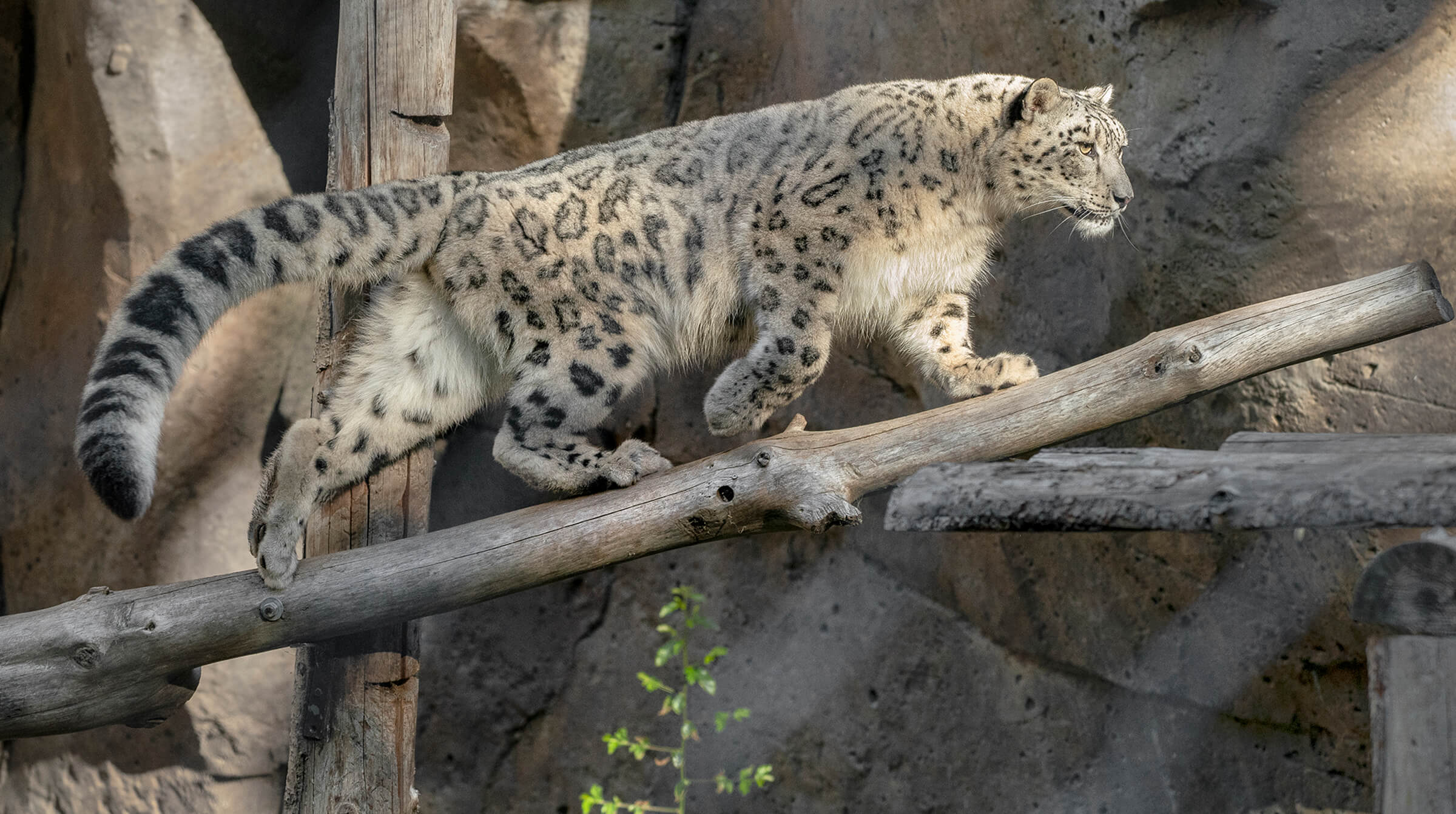
A Different Kind of Leopard
“There are about 38 species of wild cats, and there is not that much variation—but snow leopards have evolved to successfully survive in their harsh habitat,” Todd said. Snow leopards have developed many adaptations to survive in snowy and bitterly cold mountain habitats, in high elevations where oxygen levels are low. Those adaptations include short forelegs and large paws for making their way through snow, long and flexible hind legs for making spectacular leaps, and a long and flexible tail—the longest tail of any cat, in comparison to body length—for balance. They have a thick fur coat that becomes even thicker with wooly undergrowth in extreme cold weather, thick, fluffy fur on their tail, which they can use as their own carry-along “comforter,” and an enlarged nasal cavity to warm freezing air before it enters their lungs. Their big paws—with fur between the pads—provide added protection and improved traction on snow.
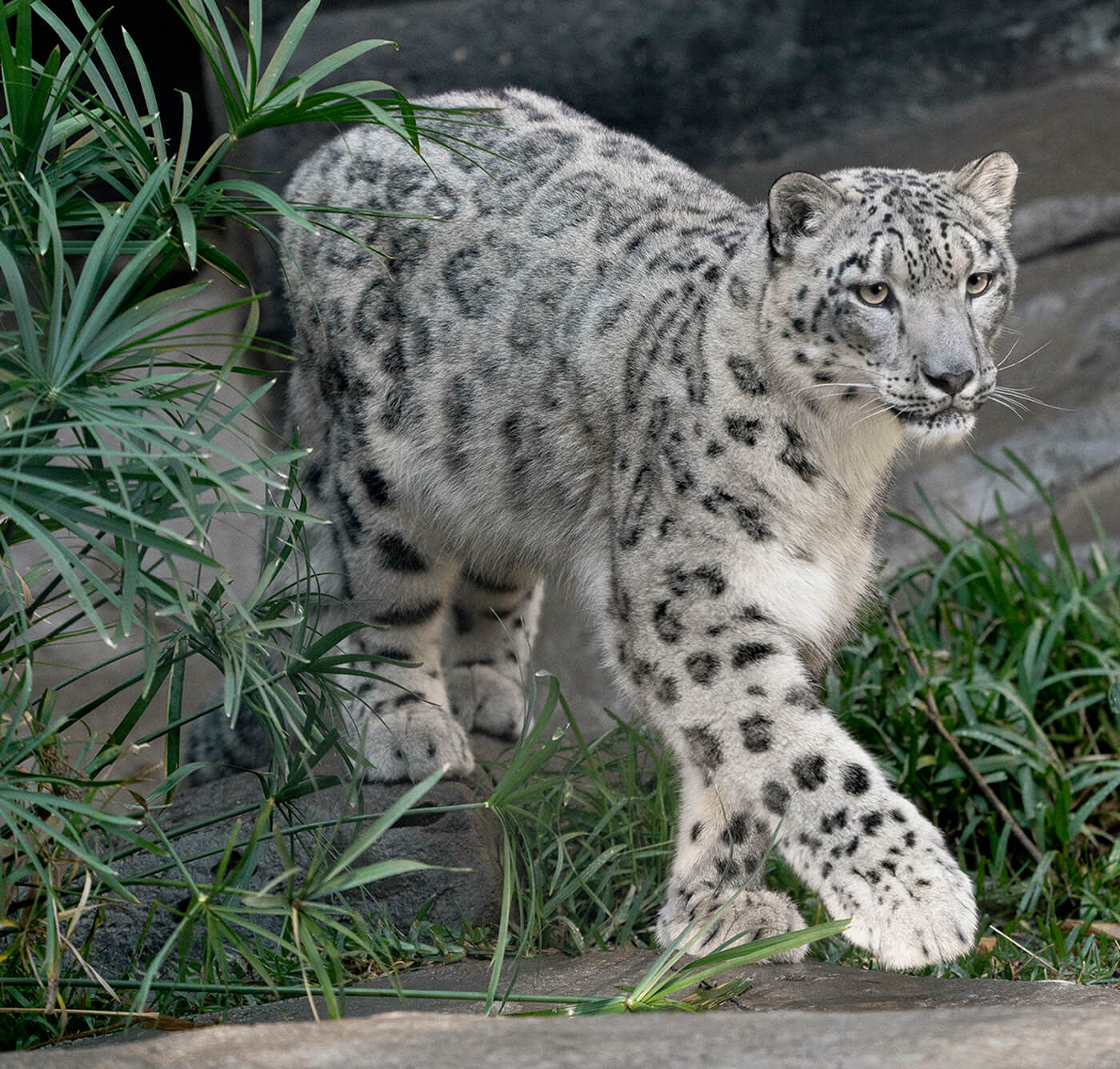
BORN TO BE COOL
Snow leopards are well adapted to survive in extreme cold, with a dense fur coat that becomes even thicker as seasonal temperatures drop, and an enlarged nasal cavity to warm freezing air before it enters their lungs.
 The 5 countries the Snow Leopard Trust works with contain 75 percent of the snow leopard population.
The 5 countries the Snow Leopard Trust works with contain 75 percent of the snow leopard population.
Snow leopards have a body length of about 39 to 51 inches—with a tail almost that long—and typically weigh from 60 to 120 pounds. They are crepuscular, meaning they are most active at dawn and dusk. Big cats have a reputation for being high-energy predators, but snow leopards are unique. “These guys are so mellow, compared to other cats,” Todd said. “Snow leopards are the only large cats that have never been reported to attack a human. They are so mild, so shy. There are some challenges that go with that—but not the same ones as working with cats on a high-amped level, like Amur leopards. Even in the wild, a shepherd boy can shoo away a snow leopard.” Unfortunately, because they will not defend themselves against human attacks, many snow leopards have been killed by people who keep livestock.
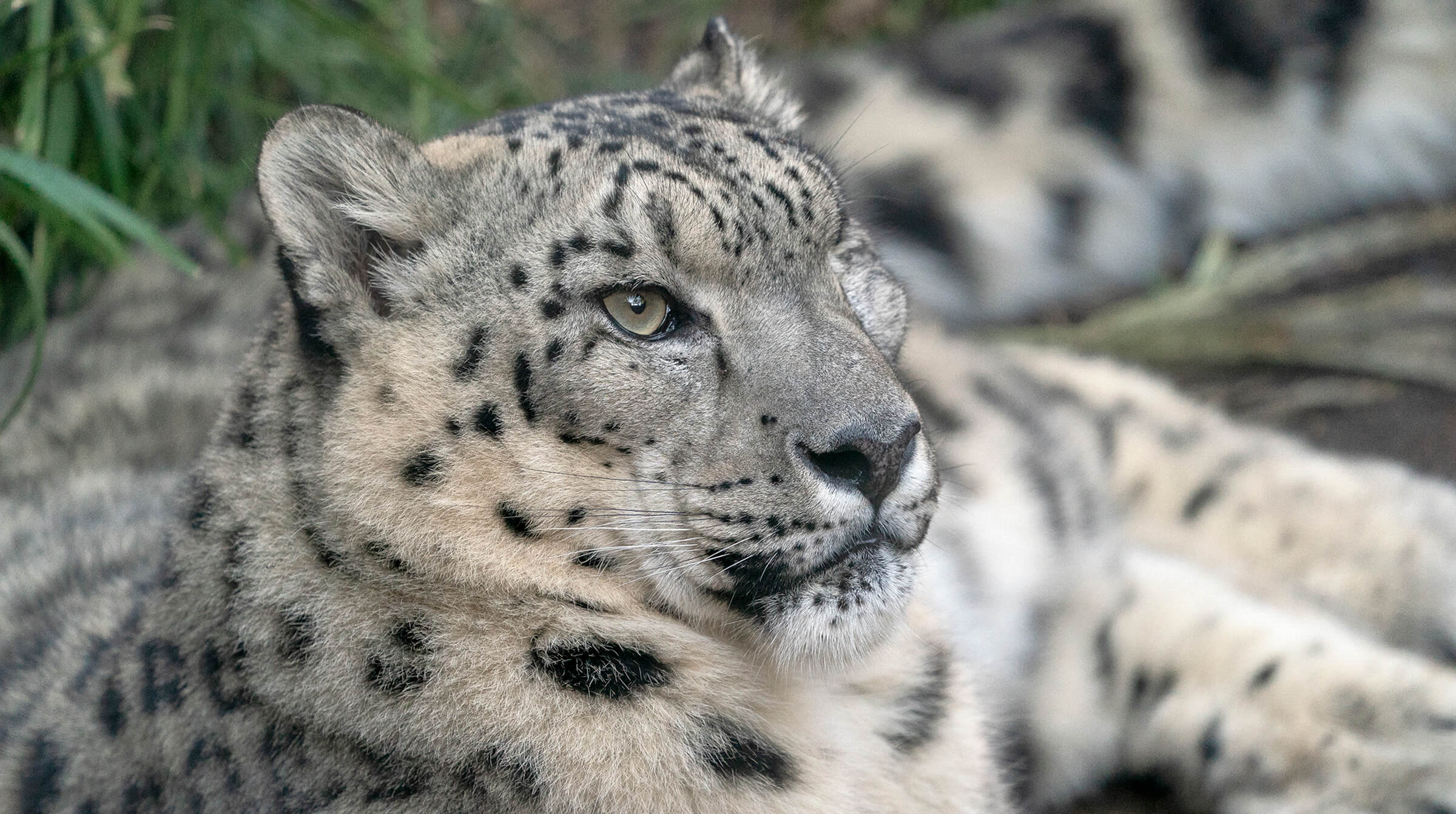
 The Snow Leopard Trust estimates between 3,920 and 6,390 snow leopards are left in their wild habitats in 12 Asian countries.
The Snow Leopard Trust estimates between 3,920 and 6,390 snow leopards are left in their wild habitats in 12 Asian countries.
Help for Snow Leopards in Asia
In addition to our work to help build a healthy assurance population of snow leopards through participation in the snow leopard SSP, San Diego Zoo Global supports the Snow Leopard Trust in its conservation work in five nations that have the largest populations of snow leopards—China, India, Kyrgyzstan, Mongolia, and Pakistan. This nongovernmental organization takes a multipronged approach to snow leopard conservation. They track, study, and protect the animals in the habitat, and they also partner with and support local herders and their families, so that snow leopard conservation becomes an integral part of the communities’ way of life. The Snow Leopard Trust trains local people living in snow leopard areas to build predator-proof corrals, and they have established community insurance programs to compensate herders for livestock losses, insuring 11,600 livestock last year alone.
The Snow Leopard Trust has also instituted programs to help herders care for their livestock, vaccinating 90,000 animals last year and helping reduce the number of livestock deaths by up to 50 percent in Pakistan. “In actuality, the vast majority of livestock losses in snow leopard habitat areas are from poor husbandry, with animals not in the best of health, and only a small percentage of losses are from predator attacks,” Todd explained. Community members are also learning how to use yak and camel wool to craft goods they can sell to support their community—increasing household incomes for 400 families last year by an average of 40 percent. “The community signs off to do no harm to snow leopards and becomes self-policing,” Todd said. “These efforts have been remarkably successful. It has been more than three years since there was a snow leopard killed in areas where the Trust has been working. These communities have been assisting in trail camera projects and reporting poachers. It has been a bright spot—an example for other conservation efforts, for other species.”
Back on Center Street, only time will tell whether 2019 will bring snow leopard cubs for Penny and Ramil. If all goes well during their short mating window, the pitter-patter of little paws could arrive in the spring. Keep watching, but look closely—these elusive cats may be spotted, but they aren’t easy to spot.

